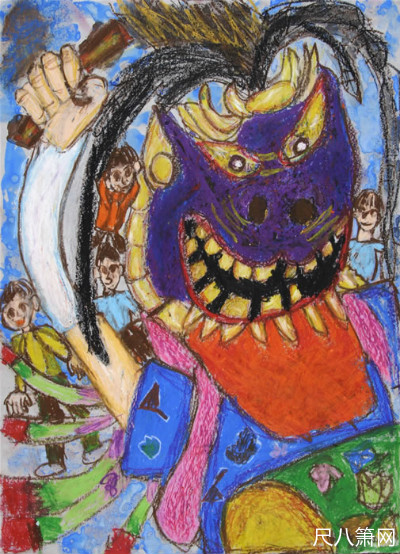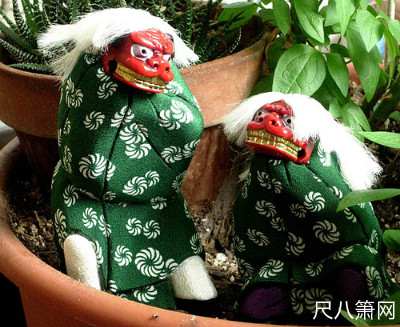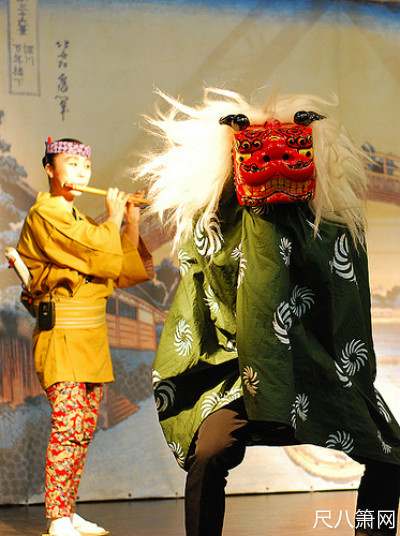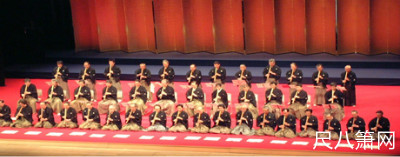尺八名曲欣赏 - 云井狮子 ( Kumoi Jishi )
基本上, 这首曲子是一首很适合刚入门,对尺八古典曲目有兴趣的人,曲目旋律明确,简单,可独奏,可二重奏,三重奏,可多人齐奏,可与其他乐器合奏,没有快速且複杂的指法,气息的运用没有太大的难度,即使初学者,对气息控制还不是太理想的人,也不太会有气不足的问题,即使自己看谱练习都不至于太困难,个人感觉,很适合当一首热身,或练习曲来吹. 这也是今天介绍这一首的主要想法,有人认为,古曲较难入门,甚至不易引起共鸣,这首曲子,旋律轻快,当成入门曲还算是蛮容易上手,有兴趣的可以试著练习看看. 在之前文章中有乐谱的下载,自己一时找不到,有兴趣的跟朋友询问一下,或留下e-mail.
尺八曲名中如有「狮子」,一般是指曲目带有庄重且华丽的旋律。在日本,狮子代表 力量,功成名就的隐喻所以在尺八曲目中,带有狮子二字的曲目众多,这些曲子,在节日,或在一般民间庆典时常被拿出来演奏.也有代表驱赶厄运,不洁的东西,邪灵等等的用意,在一般以祭祀,修身,养性的尺八曲目中,算是比较特殊的戏曲. 这些曲目有很大一部分是属于合奏曲目,甚至也可以配合歌唱,尺八有时是主奏,但也经常被当成伴奏的乐器.
曲名中有「狮子」的曲子,数量上比起其他有动物曲名的曲子,数量上还蛮吓人的,如果调查一下在尺八曲目中被用的最多的动物,如「鹤」,「鸟」「鹿」,「鱼」,「凤」,「龙」,「虎」,........用的最多的,大概非「狮子」莫属. 在网路上搜寻了 一下,有「狮子」二字的曲目,分不同时期,也被分成很多类型,多看一些网页介绍,也发现似乎分类也不是太清楚,其中也有几首被归类到都山流的曲目中,如果您对这些分类有疑虑,可以点选最下方的网页,自己去做更进一步的探讨跟研究.
琴古流, 地歌(地方歌谣): 堺狮子(栄狮子)、目黒狮子、曙狮子、越后狮子、难波狮子、八千代狮子、三段狮子、御山狮子、三段狮子 (哪几首是尺八主奏,不太清楚)
明暗: 外に狮子头 、狮子、堺狮子、六段狮子、吾妻狮子
三曲合奏: 越后狮子、难波狮子、八千代狮子、吾妻狮子、御山狮子、东狮子. 其中地歌(地方歌谣): 日本江戸时期作曲八千代狮子,属尺八为主,筝,胡琴伴奏,属三重奏合奏曲,有时三曲合奏,也用到十七弦。

Copyright : http://www.narita-childart.jp/file/9b_img/y/9y18.jpg

Copyright : http://www.flickr.com/photos/alastair_lomas/3011899883/

Copyright : http://www.flickr.com/photos/22462089@N02/2163893249/

Copyright : http://www.flickr.com/photos/jmgphotos/3243894649/
平成16年5月15日第67回三曲名流大会 青木铃慕编曲 云井狮子合奏
用到「云井」二字的尺八曲也不少,有 云井铃慕、云井虚空、云井管垣、云井狮子、云井三谷棺垣. 还有哪些,完全不清楚. 为何要用「云井」二字,不敢太肯定,但「云井狮子」 英文有人解释成「在天际云雾间飞翔起舞的神狮子」. 不知道自己翻译的是否恰当,大家看看,参考即可.
大部分人认定, 云井狮子是归属于介于琴古,明暗的「博多一朝轩系」的曲目.在日本明治时期(1868 - 1912),才被介绍到东京.一朝轩,是京都明暗系的分支寺庙,座落于日本的九州-福冈,这首曲子据说在九州地区很普遍,知名度也高. 由琴古流的尺八演奏家Yoshida Iccho将其重新编写后放入琴古流曲目中,后人也将其改编成二重奏曲目,如海童道,横山胜也系. 2004年,在国际尺八大会,日本的两位女性尺八演奏家,子,金子朋沐枝及松下春山吹奏的「云井狮子幻想」,则属改编曲目,也很好听.
这首曲目基本上可被分成三部分,大部分音阶都位于中音,高音段,低音域的部分较少.并未设定特定尺寸尺八演奏,一般演奏在接近后段时,呈现轻快节奏,吹奏速度较第一,二段快上许多,但无特殊限制以某种方法最合适. 比起其他古曲,这是一首适合自学的尺八曲目之一.
云井狮子 - 大陆网站,可全曲试听 (吹得很好)
http://www.nowok.net/Music/54458f2ed5e0c024.shtml
日本传统音乐 -《日本:尺八的杰作》(Japan:Splendor of the Shakuhachi)[MP3!] 可全曲下载,其中含云井狮子(有伴奏)
http://lib.verycd.com/2005/03/23/0000043381.html
免出隆山云井狮子(4.8MB) 试听(参考,参考即可)
http://www.ne.jp/asahi/mendels/shakuhachi/Kumoijishi.mp3
Youtube上的youtube (以下两首参考,参考即可)
http://www.youtube.com/watch?v=BZ-AJm7bsyM (还有乐谱)
http://www.youtube.com/watch?v=9I-Jdb4eALc&NR=1
参考资料网页:
http://ja.wikipedia.org/wiki/%E5%9C%B0%E6%AD%8C
http://www.komuso.com/pieces/Kumoi_Jishi.html
http://ja.wikipedia.org/wiki/%E5%B0%BA%E5%85%AB%E6%9B%B2%E4%B8%80%E8%A6%A7
http://www.mejiro-japan.com/system/detail.php?a_id=1324
http://members3.jcom.home.ne.jp/hana-showbu/kyokumokuitiran.htm
三曲歌词解说 : http://hennaog3.hp.infoseek.co.jp/contents.html
http://www.komuso.com/pieces/Kumoi_Jishi.html
Copyright @ Seldin, Ronnie
以下内容有部分很好玩,作者几乎把所有传说统统放进来下面这一篇.
作者特别提到,这首曲子不是用来"打禅,吹禅",而且只适合在中午之后的时间吹奏.这首曲子也在婚礼时被拿来演奏.
This piece is also called Kumoi No Kyoku, Niagari Jishi and Akebono Jishi, and is especially popular in Kyushu. Kumoi Jishi is also the name of a koto tuning, and niagari is a shamisen tuning. Akebono refers to transposing a piece up one fifth. This may account for these other names.
Several versions of this piece exist. It is said that this version, which is closer to Sugagaki style, was originally brought to Tokyo from the Itcho Ken Temple in Kyushu during the Meiji era. This temple descended from the Meian Temple in Kyoto. This version was arranged by the Kinko School grand master Yoshida Itcho, and then taken into the Kinko School.
Kumoi Jishi was almost lost for a while, but Junske Kawase I, while traveling, heard an old koto player, Y oshizumi, playing the version he had memorized. Kawase's notation is considered the most original version of the piece.
Japan has many forms shishi-mai, or lion dances, ranging from formal high art to children's performance at folk festivals. This, like all jishi-related pieces, retains the lively, spirited feeling of the traditional lion dance. It is a joyous piece, suited to celebrations and congratulatory occasions. Shakuhachi versions of Kumoi Jishi are not actually lion dance music meant to accompany actual dancing; instead, they are meant to evoke the mood of this dance.
Kumoi refers to the sky, and may symbolize the heavens and / or the rarified heights of the imperial court. Shishi and jishi are variants of the same word. In Japanese, sounds can change for easier pronunciation when certain sounds are joined. For instance, "shishi" becomes ''jishi,'' and "kawa," river, becomes "gawa," as in Kumoi Jishi and Nakagawa.
The jishi, or shishi, is a mythical beast from China; according to tradition, they lived on a mythical mountain called Seiryozan. Jishi are variously depicted as doglike lions, dragons or deer. These felicitous creatures are said to especially enjoy dancing playfully among clouds or peony flowers, accompanied with butterflies that sometimes tease them. Jishi have magical properties, and can repel evil spirits. MonjuBosatsu, the god of Wisdom, is often depicted riding through the heavens mounted on a jishi. Pairs of guardian jishi statues are often found at entrances to buildings, especially temples and banks, with the male and the female on either side of the entrance door. The male jishi has a globe under his paw, the female, a puppy, symbolizing their respective dominions, the earth and the family.
Like Azuma No Kyoku, this is a gikyoku, which means a playful piece not to be played by Zen monks in the morning for meditation. Rather, performing it is reserved for the less serious afternoon times or as a performance piece while begging for alms. These pieces were called hiru-kana, "from noon."
Today, this piece is played on joyous occasions, such as weddings.
It is sometimes performed in a slow, stately manner, and at other times, with a very light, playful feeling. It can evoke either the majesty of the mythical lion upon which Monju-Bosatsu, the Buddha of Wisdom, rides through the heavens, or the dancing of peasant children In their costumes at a festival, or perhaps, a jishi dancing among the clouds like a kitten or puppy chasing butterflies in a garden full of blooming peonies. The whole second section may be played twice; if this is done, the second repetition is generally performed at a faster tempo.
转自台湾山城(王锦德)老师博客:blog.xuite.net/shakuhachi.taiwan
评论列表: